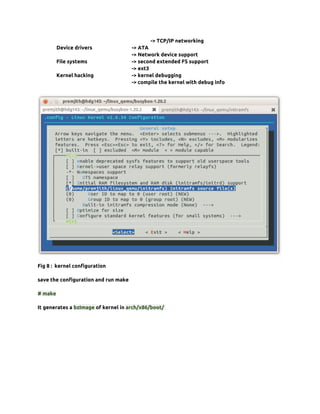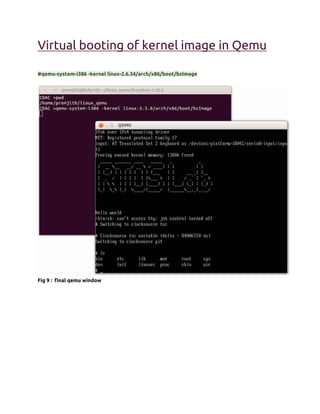Development platform virtualization using qemu
- 1. Platform Virtualization (i386) for kernel booting, debugging and testing Requirements Linux machine (Virtual or Real) Qemu, busybox, initramfs, kernel packages : build-essential, libncurses5-dev, vnc4server
- 2. Installations Qemu: is a generic and open source machine emulator and virtualizer. http://wiki.qemu.org Method 1: Install a virtualbox virtual manager to run ubuntu 12.04 in windows 7. Then updated the ubuntu packages , means the initial updates. Then installed qemu , # sudo apt-get install qemu after installation check whether the qemu is installed correctly, run the command, # qemu-system-i386 popup a black qemu windows shows some no disk found notification. Fig 1 : Qemu window
- 3. Method 2: Download the latest qemu source from http://wiki.qemu.org. Extract the source and install # tar xf qemu-1.2.0.tar.bz2 # cd qemu-1.2.0.tar.bz2 # sudo ./configure --target-list=i386-softmmu # sudo make # sudo make install Check the qemu working, run command # qemu-system-i386 popup a black qemu windows shows some no disk found notification [Fig. 1]. Fig 2 : working qemu window of a custom kernel
- 4. Busybox: The Swiss Army Knife of Embedded Linux http://busybox.net Download latest busybox tar from the website and extract it. #tar xf busybox-1.20.2.tar.bz2 #cd busybox-1.20.2 #make allnoconfig #make menuconfig Select appropriate options in menuconfig. busybox settings -> build options -> static binary[essential] coreutils -> enable cat, touch, chmod, chroot, cp, echo, ln, ls, mkdir, mknod, pwd, rm, rmdir console utils -> clear editor -> vi find -> find, grep init -> poweroff, init [essential] linux system utils -> mdev, mount[essential] network utils -> ping, arp, httpd, ifconfig shells -> ash, choose which shell is aliased to sh & bash name[essential] save the configuration. #make #make install make install command copies the binaries generated to _install directory.
- 5. initramfs: is a root filesystem which is embedded into the kernel and loaded at an early stage of the boot process. Create a main directory initramfs #mkdir initramfs #cd initramfs Create a basic folder structure #mkdir -pv bin lib dev etc mnt/root proc root sbin sys Copy some default device nodes to device directory #sudo cp -va /dev/{null,console,tty} dev Now copy the busybox binaries in _install directory into initramfs. #cd busybox-1.20.2 #sudo cp -avR _install/* ../initramfs Fig 3 : busybox copy to initramfs
- 6. Create a init script in initramfs directory #cd initramfs #sudo gedit init Fig 4: init script Change the permission settings of init script to executable #sudo chmod +x init Fig 5 : initramfs folder structure
- 7. Optional Steps for cpio archive[Optional] #find . -print0 | cpio --null -ov --format=newc> ../initram.cpio Fig 6 : copy files to archives
- 8. Kernel: Linux is a clone of the operating system Unix, written from scratch by Linus Torvalds with assistance from a loosely-knit team of hackers across the Net. http://www.kernel.org/ Download a stable kernel and untar it, Fig 7 : Kernel.org # tar xf linux-2.6.34.tar.bz2 # cd linux-2.6.34 # make allnoconfig # make menuconfig select appropriate options. general setup -> initial RAM filesystem and RAM disk support -> initramfs source [/home/premjith/linux_qemu/initramfs] Bus options -> PCI support ELF Format/Emulation -> Kernel support ELF binaries Networking Support [y] -> Networking options ->packet socket ->unix domain socket
- 9. -> TCP/IP networking Device drivers -> ATA -> Network device support File systems -> second extended FS support -> ext3 Kernel hacking -> kernel debugging -> compile the kernel with debug info Fig 8 : kernel configuration save the configuration and run make # make It generates a bzImage of kernel in arch/x86/boot/
- 10. Virtual booting of kernel image in Qemu #qemu-system-i386 -kernel linux-2.6.34/arch/x86/boot/bzImage Fig 9 : final qemu window

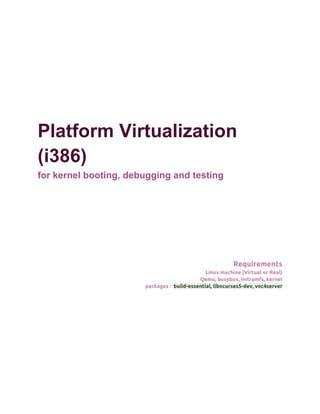
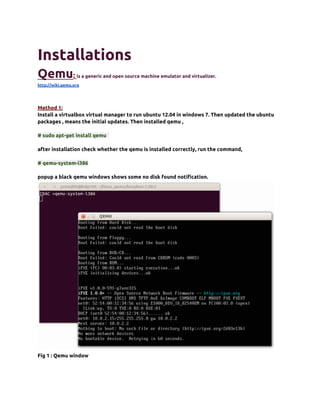
![Method 2:
Download the latest qemu source from http://wiki.qemu.org. Extract the source and install
# tar xf qemu-1.2.0.tar.bz2
# cd qemu-1.2.0.tar.bz2
# sudo ./configure --target-list=i386-softmmu
# sudo make
# sudo make install
Check the qemu working, run command
# qemu-system-i386
popup a black qemu windows shows some no disk found notification [Fig. 1].
Fig 2 : working qemu window of a custom kernel](https://image.slidesharecdn.com/1platformvirtualisation-121219041440-phpapp02/85/Development-platform-virtualization-using-qemu-3-320.jpg)
![Busybox: The Swiss Army Knife of Embedded Linux
http://busybox.net
Download latest busybox tar from the website and extract it.
#tar xf busybox-1.20.2.tar.bz2
#cd busybox-1.20.2
#make allnoconfig
#make menuconfig
Select appropriate options in menuconfig.
busybox settings -> build options -> static binary[essential]
coreutils -> enable cat, touch, chmod, chroot, cp, echo, ln, ls, mkdir, mknod,
pwd, rm, rmdir
console utils -> clear
editor -> vi
find -> find, grep
init -> poweroff, init [essential]
linux system utils -> mdev, mount[essential]
network utils -> ping, arp, httpd, ifconfig
shells -> ash, choose which shell is aliased to sh & bash name[essential]
save the configuration.
#make
#make install
make install command copies the binaries generated to _install directory.](https://image.slidesharecdn.com/1platformvirtualisation-121219041440-phpapp02/85/Development-platform-virtualization-using-qemu-4-320.jpg)
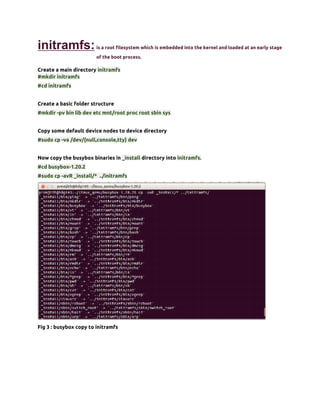
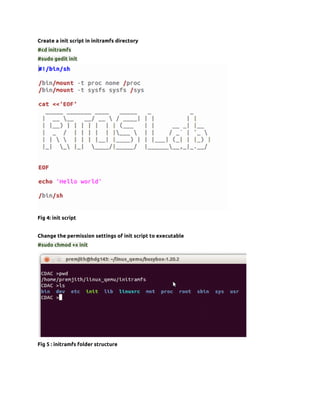
![Optional Steps for cpio archive[Optional]
#find . -print0 | cpio --null -ov --format=newc> ../initram.cpio
Fig 6 : copy files to archives](https://image.slidesharecdn.com/1platformvirtualisation-121219041440-phpapp02/85/Development-platform-virtualization-using-qemu-7-320.jpg)
![Kernel: Linux is a clone of the operating system Unix, written from scratch by Linus
Torvalds with assistance from a loosely-knit team of hackers across the Net.
http://www.kernel.org/
Download a stable kernel and untar it,
Fig 7 : Kernel.org
# tar xf linux-2.6.34.tar.bz2
# cd linux-2.6.34
# make allnoconfig
# make menuconfig
select appropriate options.
general setup -> initial RAM filesystem and RAM disk support
-> initramfs source [/home/premjith/linux_qemu/initramfs]
Bus options -> PCI support
ELF Format/Emulation -> Kernel support ELF binaries
Networking Support [y] -> Networking options
->packet socket
->unix domain socket](https://image.slidesharecdn.com/1platformvirtualisation-121219041440-phpapp02/85/Development-platform-virtualization-using-qemu-8-320.jpg)
